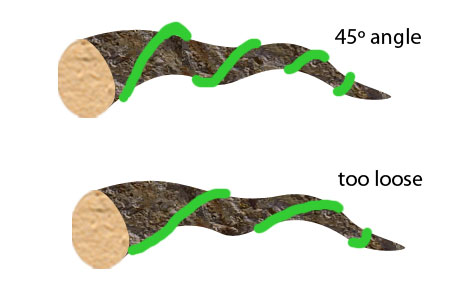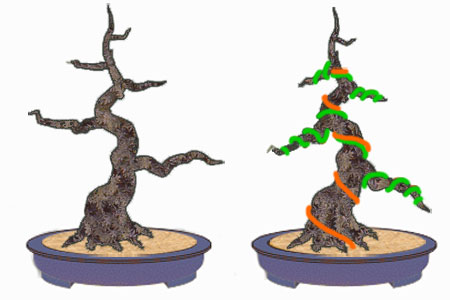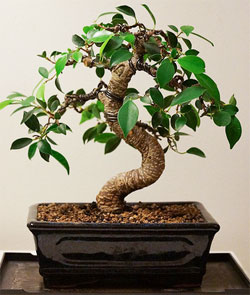A wiring technique in bonsai is used to better control and manipulate the structure of the tree. We use wiring to fill in bare spots of the tree, create a movement, or simply change the direction of the branch.
It would be very hard, and sometimes even impossible, to create the bonsai that we want without using a wire.
Correct wiring is almost an art form in itself and takes a lot of practice to get it right. If the tree is wired nicely, you can display it without wire being an issue.
Wire Types
There are two main types of wire used for bonsai: aluminum and copper. Aluminum wire is not as strong as copper, but easier to apply and easier to remove. It is better for beginners because it is much more forgiving than copper.
Although aluminum wire can be reused, I don’t recommend it, because you might damage the tree during the unwinding process. Since copper wire is much stronger, you can use thinner pieces. Copper wire is more difficult to apply and cannot be reused.
I personally like to use brown anodized aluminum wire. It is inexpensive and easy to use. The anodized coating protects the wire from corrosion while the brown color helps it to blend in with the bark. This is a great wire, especially for beginners.

Wire comes in different thicknesses from 1 to 8 mm. To wire a whole tree, start by getting reels of 1.0 mm, 1.5 mm, 2.5 mm, and 4.0 mm. Generally, for the wire to hold you need to use a wire of 1/3 of the thickness of the branch/trunk you are wiring. If the wire is too thin, it will not be strong enough to hold the branch in the new position.
How to Wire
When wiring the whole tree, start with the trunk and then move to the main branches and then to the secondary branches. The wire should be applied at a 45º degree angle.
If the angle is more than that, the wire will be too open to have enough holding capability. If the angle is less than 45º degrees, the wire coils will be too tight which can result in sap flow restriction and ultimately the death of the branch.
You also want to make sure the wire is not too loose; otherwise, it will not have any effect on the branch.

Use the trunk or nearby branches as an anchor for the wire. If you are wiring the trunk, anchor the wire by pushing one end into the soil and the roots of the tree. Try to use one wire for both nearly positioned branches if they are of similar thickness.
To make sure you have enough wire, make it 1/3 longer than the branch you are wiring. Try not to wire across the front of the tree when using one wire for both branches. Hold the wire firmly with one hand and coil it carefully around the branch towards your body.
Start wiring at the point where the branch is growing from the trunk and go down to the very tip making 45º degree coils. The LAST coil should be secured at the very tip at a 90º degree angle.
If you are trying to bend the branch down, wire over the top. When you come across a branch or a leaf while wiring, go around them. You never want to cross the wires.
So, when you are wiring smaller branches and you already have a wire on the main branch, apply it in between the coils of the main branch. When you reach the end of the branch, cut the excess wire with the wire cutters.

If you are working on a fast-growing tree, leave a little bit of room between the wire and the bark. Don’t make coils too tight to avoid wire cutting in. The thicker the branch, the harder it is to bend without it cracking.
Use both hands when bending the trunk or the branch. Go SLOW and listen for the sound of splitting or cracking. It is better to bend a thick branch in multiple steps over time than doing it at once.
To prevent the branch from snapping, test its tension prior to wiring. Some species can be wired only when they are young. With age, the branches become ‘hardened off’ and it is impossible to bend them without snapping. Some of those trees are Azalea, Bougainvillea, and Acer palmatum ‘Kiyohime’.
Although bonsai trees respond very well to wiring, it does cause a certain amount of stress. So, DON’T wire sick or weakened trees as it might slow the recovery. Wait for it to get healthier before applying the wire.
Best Time For Wiring
The BEST TIME of the year for wiring your bonsai depends on the species of your tree and the climate it is growing in. Many believe that most of the species can be wired during any time of the year. From my experience, there is a particular time of the year that is better than others.
- Pine – The best time of the year for pines is late fall or early winter when the sap is not flowing and the branches are more flexible. By the end of summer, the increase in branch thickness will be over, and wiring after this time will allow you to keep the wire on for a full year.
- Deciduous – Could be wired anytime from early spring to early fall. In spring, it is easy to wire because you can see the branches. While wiring, be careful not to disturb any of the buds. Wait till the tree loses all the leaves before wiring in the fall. That way, you will be able to see the structure of the tree better.
- Coniferous – Can be wired from the middle of the spring to late fall. Keep in mind, that coniferous will heal faster during the growing season than at any other time of the year. If you decide to wire in spring, you will need to rewire the tree after the new growth develops.
- Tropical species – Since they don’t have a dormancy period and are always growing, you can wire them any time of the year. Before applying the wire, defoliate the tree so you can see the branch structure. It is much easier to apply the wire when there are no leaves.
When to remove the wire
You always want to remove the wire before it cuts into the bark and leaves an ugly scar. Therefore, check your tree often, especially during the growing season.
Some of the tropical trees grow so fast, that there is almost no way of avoiding the marks. Light marks will heal within a year or two, so there is no need to worry. Severe marks might never heal leaving awful scars.
When removing the wire, always use wire cutters, because they have round heads that are specially designed to cut the wire clean without damaging the bark of the tree.
Some bonsai enthusiasts, in order to save money, like to unwind the wire and reuse it. I learned the hard way that it is a bad idea. There is a chance of damaging the buds, leaves, or branches. You can try reusing a larger more expensive aluminum wire, but don’t try to unwind copper wire.
Related articles:

